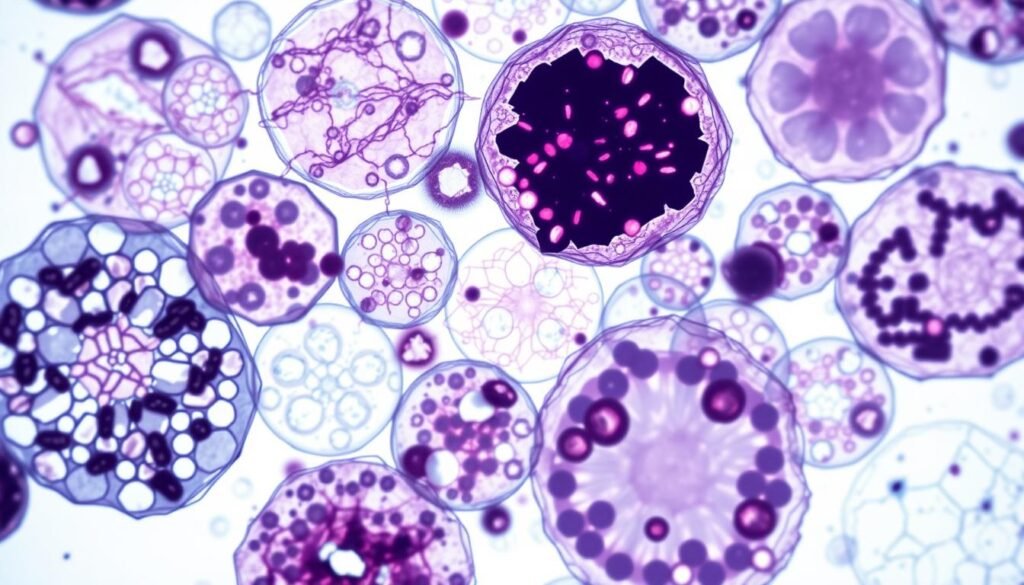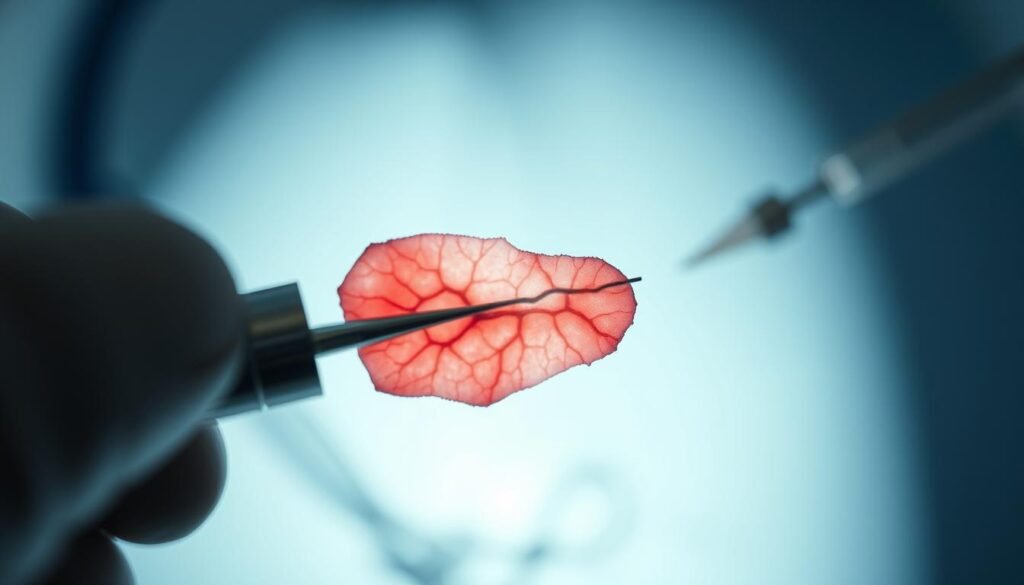Did you know it can take two to ten days to get lung biopsy results? This wait can be hard for patients and families, giving rise to worry about lung cancer. When lung cancer biopsy results positive are seen, it’s vital to know the next steps. This knowledge is key for choosing the right lung cancer treatment options.
Knowing what the results imply is the first step towards empowerment. Speaking clearly with doctors and looking up trusted info are must-dos. It’s also smart to think about a second opinion. Being well-informed eases fears, helping patients and their families face their cancer diagnosis bravely.
Key Takeaways
- The first clue of lung cancer usually comes from chest X-rays.
- Talking well with your medical team is key after a positive biopsy.
- Looking into lung cancer treatment options is crucial for care that fits you.
- Fully understanding your results helps you and your loved ones emotionally prepare.
- Getting a second opinion is a good idea to explore all treatment paths.
Understanding Lung Biopsy Procedures
Lung biopsies are key for diagnosing lung cancer. They let doctors get tissue or fluid samples for tests. Various techniques help find out what’s wrong in the lungs. Knowing the results helps decide the best care.
Common Biopsy Techniques for Lung Cancer
Different biopsies are used based on the situation. Here are the common ones:
- Fine Needle Aspiration (FNA) – A thin needle takes out cells to look at.
- Core Needle Biopsy – Gets more tissue to learn about the tumor.
- Surgical Biopsy – More complex, includes surgery to reach the area.
- Thoracentesis – Removes fluid from around the lungs for testing.
- Bronchoscopy – Lets doctors see and take samples from the airways.
The biopsy method chosen depends on the tumor’s location and the patient’s health. Different biopsies give different levels of detail, vital for an accurate diagnosis.
How Lung Biopsy Samples are Analyzed
After collection, the sample goes to a pathologist. It’s prepared for a close look under a microscope. The analysis includes:
- Permanent section – Tissues are fixed in formalin for thorough examination.
- Frozen section – Offers quick results for on-the-spot decisions during surgery.
Pathologists use special stains like TTF1, Napsin A, P40, and P63. These tests pinpoint the type of lung cancer. Knowing details like tumor grade and margins helps predict the patient’s outcome.
What Does a Positive Lung Cancer Biopsy Result Mean?
A positive lung cancer biopsy result is very important. It shows that cancer cells are present. These results are crucial for deciding on the right treatment. It’s important for patients to understand their biopsy reports to plan the next steps in their care.
Defining Positive Findings in a Biopsy Report
When a biopsy is positive, it means the cells are cancerous. The report gives details like the cancer type and stage. This information helps patients fully understand their diagnosis.
Importance of Accurate Diagnosis
An accurate diagnosis after a positive biopsy matters a lot. It helps decide the best treatment options. Understanding the pathology report is key to making good health decisions. Sometimes, more tests are needed to clear up any doubts, so the treatment plan is based on solid facts.

Types of Lung Cancer Identified by Biopsy
Knowing about different lung cancer types is key for correct treatment. Biopsies help identify these cancers reliably. They mainly split them into two groups: Non-Small Cell Lung Cancer (NSCLC) and Small Cell Lung Cancer (SCLC). Each type has its own features that affect how doctors treat them.
Non-Small Cell Lung Cancer (NSCLC)
Non-Small Cell Lung Cancer is the most common kind. It includes types like adenocarcinoma and squamous cell carcinoma. They grow and spread in different ways. NSCLC grows slower than other cancers. It usually shows up as one mass or a few spots in the lung.
Small Cell Lung Cancer (SCLC)
Small Cell Lung Cancer is more aggressive. It starts in neuroendocrine cells and spreads fast. This means it can quickly move to other parts of the body. Catching SCLC early is important. It needs stronger treatment early on due to its fast growth.
Pre-cancerous Conditions
Biopsies can also find early signs of cancer. These are chances to stop cancer before it starts. Squamous cell carcinoma in situ and atypical adenomatous hyperplasia are examples. Watching these conditions closely and managing them can prevent serious cancer. For more on biopsy findings, visit this resource.

Receiving Your Cancer Diagnosis
Getting a cancer diagnosis is often hard and scary. It’s important to understand your pathology report during this time. The report has key information like the cancer type and what treatments might work best. It can be tough to understand all the medical terms, so talking with your healthcare team is crucial.
Understanding the Pathology Report
Pathology reports are important for knowing your cancer better. They tell you about the tumor’s type, grade, and other details that help choose the right treatment. It’s important to talk about any hard parts of the report with your doctors. They can explain things and make sure you understand. You can also look for more resources to help. Learn more by visiting what to expect from lung cancer screening.
Who Involves in Diagnosis and Report Interpretation
Different experts help with your diagnosis and report. Oncologists, pathologists, and nurses all play a part. Oncologists make your treatment plan. Pathologists check biopsy samples for cancer. Nurses and others answer your questions and offer support. This team work helps give you the best care and lets you make informed choices.
Positive Lung Cancer Biopsy Results: What’s Next?
Finding out you have lung cancer from a biopsy is overwhelming. It’s crucial to understand the next steps for you and your family during this difficult time. Talking with doctors about *cancer treatment plans* is key. These talks will help make a plan for what comes next.
Next Steps After a Positive Diagnosis
After a positive lung cancer biopsy, here are steps to take:
- Talk with oncologists about further testing to find out how much cancer there is.
- Learn why imaging scans are important. They show how far the cancer has spread.
- Look into surgery options, like thoracoscopy or open biopsy. These can test and treat cancer right away.
- Make sure all your medical info is in order. This helps keep talks with doctors smooth.
Preparing for Further Tests
Getting ready for further testing means doing a few things:
- Don’t eat or drink for 8 hours before some tests.
- Know about risks, like pneumothorax. It’s when air leaks into the space around the lungs.
- Watch for signs of problems after a biopsy. This includes fever or bad chest pain.
For more on lung biopsy procedures, check out this resource. Taking these steps helps create a plan that fits your needs.

Further Testing and Its Significance
After a positive lung cancer biopsy, further testing is key to planning treatment. It involves staging the cancer to know how far it has spread. This can include imaging tests like CT scans or MRIs. These tests check if cancer has spread to lymph nodes or other organs. This affects the choices for treatment and the possible outcomes.
Staging the Cancer
Knowing the stage of lung cancer helps create an effective treatment plan. It guides doctors in choosing surgery, radiation, or chemotherapy. By fully understanding the cancer stage, healthcare teams can better track the progression. This helps in adjusting treatments to improve outcomes.
Importance of Genetic Testing
Genetic testing is crucial in lung cancer care today. It looks for DNA changes that indicate how cancer will react to targeted therapies. Markers like ALK, EGFR, and KRAS guide personalized treatment plans. These tests not only guide treatment options but also make them more effective.
Patients should talk with their doctors about the newest research. This ensures they get care that’s based on the latest knowledge in lung cancer treatment. For information on early symptoms, check out this resource.
Exploring Lung Cancer Treatment Options
Lung cancer treatment options depend on the disease’s type and stage. They often include surgery, radiation therapy, and chemotherapy. Each method has different considerations and outcomes.
Surgery: Types and Considerations
Surgery is a key method for treating lung cancer. It aims to remove tumors and affected lymph nodes. Depending on the patient’s case, doctors may choose from several surgical types. Thoracic surgeons perform these critical operations. Recovering from surgery can last 6 to 8 weeks. This varies by the procedure, patient’s health, and healing ability.
Radiation Therapy and Its Role
Radiation therapy is crucial for treating lung cancer. It uses high-energy beams to kill cancer cells. This therapy helps shrink tumors before surgery and treats inoperable cancers. SBRT/SABR and proton therapy offer targeted treatment. They limit damage to nearby tissues. Patients should discuss radiation therapy’s role in their treatment with oncologists.
Chemotherapy: What to Expect
Chemotherapy uses drugs to destroy cancer cells throughout the body. For some lung cancer stages, it’s the main treatment. Yet, reactions to chemotherapy can vary widely. The rising importance of chemotherapy is shown by the growth of the anti-tumor drug market. Patients should talk with doctors to find the best treatment option. For more on biomarker testing and its benefits, read more here.
Understanding Lung Cancer Prognosis
Understanding lung cancer prognosis means looking at many factors. These include the type of lung cancer, its stage when found, patient’s health, and how well they respond to treatment. Early detection helps a lot. It means treatments can work better, improving outcomes.
Factors Influencing Prognosis
Many factors affect lung cancer’s prognosis. For example, non-small cell lung cancer (NSCLC) often has a different outlook than small cell lung cancer (SCLC). The patient’s daily ability to function, along with any genetic changes or tumor traits, also matter. Knowing these details helps doctors and patients plan better, personalized treatments.
Importance of Early Intervention
Early action against lung cancer is crucial. It opens up more and often better treatment choices. Also, it usually means a better chance of living longer. Getting checked early when you notice symptoms and sticking to recommended screenings is key. This can catch the cancer sooner, making a big difference in treatment success.